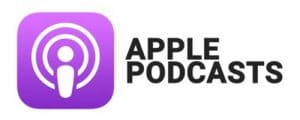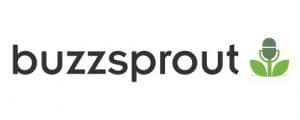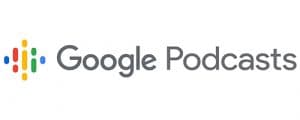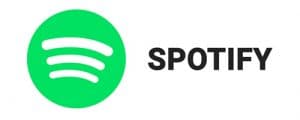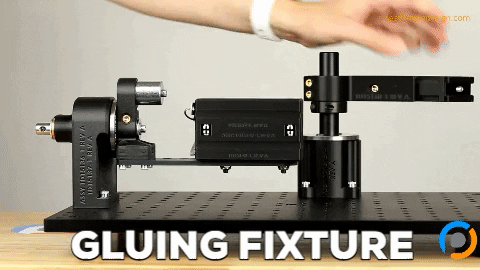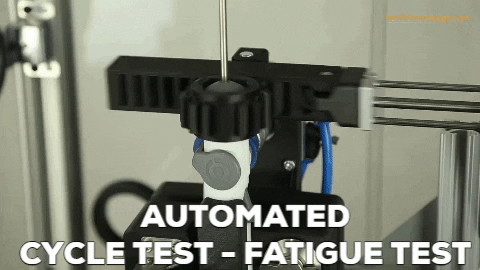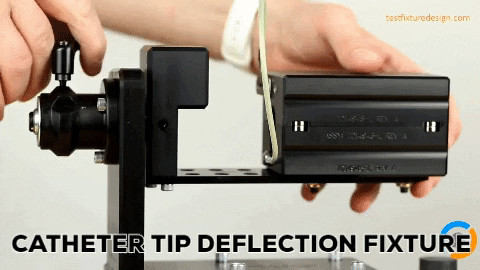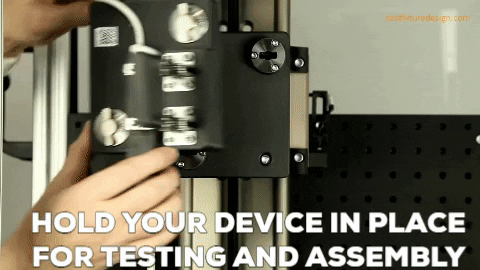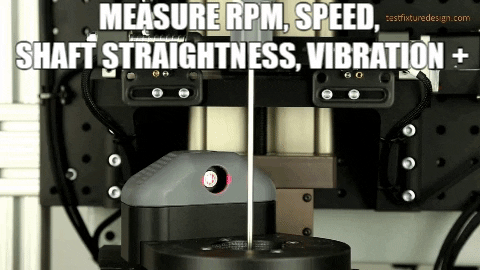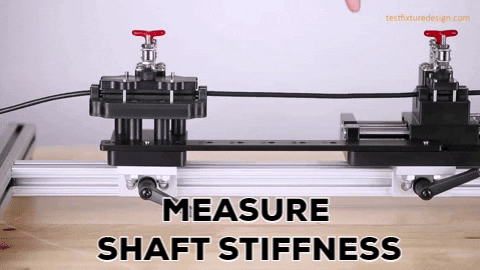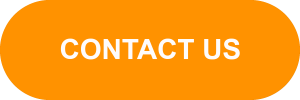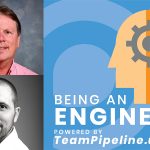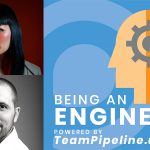Ryan Eder | Relentless Empathy & Going Deep On Understanding The Problem
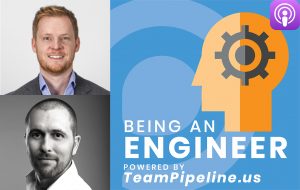
Who is Ryan Eder?
Six months after graduating, Ryan Eder entered his senior thesis project, a novel piece of fitness equipment, into the International Design Excellence competition, along with 1700 other entries from 35 countries. He won.
This thesis marked the start of his journey. The beautifully designed piece of hardware became an equipment-agnostic software, lowering the barrier to entry into fitness, thanks to his company IncludeHealth.
Hear Ryan’s full story in this episode and learn the process of how he understands his customers’ problems. Ryan’s clients describe him as someone who understands their problems. In fact, his clients get so emotional when using the end product for the first time.
EXPAND TO VIEW EPISODE TRANSCRIPTION
SUMMARY KEYWORDS
draw, people, problem, design, machine, equipment, include, wheelchair, started, fitness, priority, sensor, ryan, opportunity, building, build, thought, healthcare, work, big
SPEAKERS
Ryan Eder, Aaron Moncur, Presenter
Presenter 00:00
Hello dear listener, we are looking to add a new member to our engineering team again. Ideally, we’re looking for a Senior Level Mechanical Design Engineer in the Phoenix area who has experienced designing custom automated machines, equipment and test fixtures. Also, having working experience with controls and system integration would be a big plus. If you’d like to apply or suggest someone, please email us at info@teampipeline.us. The Being an Engineer Podcast is a repository for industry knowledge and a tool through which engineers learn about and connect with relevant companies, technologies, people resources and opportunities. Enjoy the show.
Ryan Eder 00:48
I use the term ‘relentless empathy’ a lot. And it is that paired with immersion of really just putting yourself in someone else’s shoes. And still like just having those phone calls made it to where I got frustrated with the responses. Obviously, I’m not impacted by it. Right like but I got frustrated. So then so then it took me to the next level of immersion, where I rented a wheelchair and I went to local facilities and tried to work out in the chair myself.
Aaron Moncur 01:32
Hello, and welcome to another episode of the Being an Engineer Podcast. Today we’ve got Ryan Eder who is an industrial designer by education and has contributed to the design of products for high profile brands such as Dial Herbal Essences, TaylorMade Golf, Logitech, Sirius, Microsoft, and Nike. Ryan is currently the Founder and CEO of Include Health where they provide digital tools to support muscular skeletal services. Ryan, welcome to the show.
Ryan Eder 02:03
Thanks, Aaron. appreciate you having me.
Aaron Moncur 02:05
You bet. So tell me what made you decide to become an industrial designer?
Ryan Eder 02:13
So when I was young, I always just loved to draw, like, like, when I was in elementary school, it would be like Friday nights, we’re going to Myer’s getting a comic book and a poster board and like drawing, like spawn, and stuff like that, okay. It’s like I just, I would just draw comic stuff all the time. And so like, that was always decent in math. And so like, when going through high school, and we were looking at colleges, originally thought, oh, engineering, like you’re creative and math, maybe engineering, and we would go visit the schools and like, I would see it and I was like, Yeah, kind of, right. I was like, but this is not quite as, like on the art side, or the right side of the brain that like I’m into. And I was talking to one of the schools visited, and they were like, Oh, you should check out you know, industrial design. And I had never even heard of it. I was like, why, like, okay, right. And so I went to one place, and they show me around, and they’re like, ‘Where are you from?’ And I was like, ‘Well, I’m from Cincinnati.’ And they’re like, ‘Oh, well, University of Cincinnati has a tremendous industrial design program, you should check them out.’ Okay, right. And so just follow up and go and you go into the college is called dap, design, architecture, art and planning. And like, when you will go to the building, it’s immediately unique, because no, there’s no 90 degree angles. Oh, wow. Right. So right. And so it’s just unique building and you walked in there. And they have all these different design departments. I walked in, and I remember like seeing down the hallway, the showcase, there was like a sketch of an iron. And then a model of it. And click I go, my drawings come to life.
Aaron Moncur 03:55
Moment. Yeah.
Ryan Eder 03:56
It was, I was like, that was it. I was like I’m in this is this is this is what I want to do. And that was a very visceral reaction that fortunately was, was true. And I’ve just, I love every bit of it.
Aaron Moncur 04:08
Oh, what a great story. Thank you for sharing that.
Ryan Eder 04:11
Sure.
Aaron Moncur 04:12
Tell me when when you were young, I’ve always thought the ability to draw to sketch. I’ve always thought that was such a cool skill. And it’s one that I’ve never really had. And I’ve like practiced a little bit trying to figure out perspective and stuff like that. I’m not good. I’m not good. People, people who are good I look up to and I think it’s such a cool skill to have. Did you always have that skill? Like even when you were you know, I don’t know, five years old? Eight years old. Were you pretty good already? Was that just a natural talent that you had or did you have to practice a lot until you got decent at it?
Ryan Eder 04:48
I think it’s a mix of both. So like I always love the draw. I mean, I got in trouble and second grade thing for drawing Ninja Turtles during class. Time, like, right, so like when you’re reading around, I would draw those instead of actually like reading the paragraphs and going along, every time it would come to my turn to read in the I’d be sitting here drawing, right? And so I got in trouble for that. And like, I want like a year book drawing cover contest in fourth grade, like so I always like love to I always love to draw, but that doesn’t mean you’re necessarily good at drawing. Yeah. And so like, you have like, a decent like passion for it, and you get kind of better, but like, it’s interesting when, when I went to dap, like, I went up to high school went through high school, it was like, oh, Ryan is the guy that draws and you can do this. And he would draw, like, I would draw the shirts, you know, like, Falcon was the come through the school mascot. And I would draw all those. I was like, yeah, I’m the guy that can draw, and I can do this stuff. And I went, I went to design school and like, those kids could draw,
Aaron Moncur 05:48
Oh, now you’re in a group that like, everyone has that skill.
Ryan Eder 05:52
I was like, Whoa, like, okay, these guys rocked me in my place, right. And so then what was really nice about that, but they break it down to the fundamentals. And they teach you perspective and shading and like they really the first year is a fundamental year, and they’re really teaching you all these principles to take your skills up. And so I definitely, I definitely needed that to be able to get to the level to play with the other kids at school.
Aaron Moncur 06:19
Up to that point, had you had any formal training? Have you taken any classes? Or was it you know, just you looking at comic books, and…
Ryan Eder 06:27
Yeah.
Aaron Moncur 06:27
It was just hadn’t put it on paper.
Ryan Eder 06:29
Right, it would just be me kind of drawing other things I saw, and just seeing how closely I could get it. Right. I took maybe one like animation class, because I got pretty fascinated with animation early on. But it was only like a five week class or something like that. So that was my that was my first formal education and the drawing.
Aaron Moncur 06:49
I want to dig into this a little bit more, because I think drawing is again, so fascinating. It’s such a cool skill to have. I’ve always thought about artists who can look at someone’s face and just draw it right. And then, like, I try to draw someone’s face, and it looks it. I mean, it looks like a kindergartener who was really sick that day or something, you know, it’s terrible. I mean, this is really even for like an adult that doesn’t necessarily have those skills. It’s embarrassing how bad it can be.
Ryan Eder 07:22
Well, don’t don’t beat yourself up on that. Because seriously, like drawing a human face is one of the hardest things possible. Is that because, yeah, because because it is one of the most, you subconsciously recognize any deviation from what you’ve seen, because that’s what your brains processing human faces all the time. So you when something’s off, it’s immediately visible and noticeable, right. And that’s even with like, the most skilled, you know, artists. And so like, I cannot do that, like, I could not sit there and draw your face right now. And you’d be would probably be offended by it. Right? So like, and I get amazed by that these people that are able to draw these lifelike images of, you know, things that you see every day where you subconsciously would pick up on the nuances, but they were incorrect, right. That’s a whole nother level that like, I’m just, I love It’s fascinating. But I’m not there.
Aaron Moncur 08:15
Do you still have a chance to draw fairly often these days are not?
Ryan Eder 08:20
Not really. Yeah, not really. So what my current role is has moved quite past like design, design, still important part of it, but it’s a very different type of design now than that. However, what’s fun is that my daughter is six and a half. And it’s she shown an interest in drawing. Oh, wow. Yeah, so we’ll sit there and she’ll be like, let’s draw a mermaid. And, you know, like, she’ll draw like, fall on me and I’ll just be a makeup on mermaid right. And she’s like, you’re the best drawler in the world and stuff and like, it’s so cool to be able to relive it. I remember being in first grade and drawing, right?
Aaron Moncur 09:01
So and she just looks at you as her hero now, right, dad who can do this magic on paper, it’s is so great. That’s so great. Have you ever seen Art Hub for Kids on YouTube?
Ryan Eder 09:13
No.
Aaron Moncur 09:14
I think you could you could give this guy a run for his money. Yeah, it’s it’s this this dude who he’s an artist, I guess. And he has a couple of kids you know younger boys and they just record themselves a dad draw something and his son like kind of draws along with them. Okay, but they’ve gotten pretty popular now. Like my kids watch it all the time. And really, yeah, they’ll they’ll try drying things and it’s crazy how well not me personally but even just my kids can draw these things just following along with with this guy so I imagine is much the same when you’re drawing this made up mermaid and your daughter follows along. Right, it looks pretty good.
Ryan Eder 09:52
Yeah, you are impressed like like, wow, okay, like, Great. Let’s keep it going as long as she loves it right then let’s keep nurturing that.
Aaron Moncur 10:01
Fantastic. Great. Well, let’s see you, you are the Founder and CEO of Include Health right now. But you worked for several companies before that, can you maybe just give us a quick summary, maybe a minute or two of where you worked previously, and any highlights that you’d like to share about previous employers?
Ryan Eder 10:20
Sure. So like, I mean, through through college, there was a coop program where you would be able to go out and work as an intern. Now, I’m a different design firms or organizations. So I had a collection of internships that ultimately led to my job right out of school, which was at Priority Designs in Columbus, Ohio. And so I went there right out of school I and coop there in 2004. And then and then when I graduated in ’06 I got a job there right afterwards. And and that actually was my only position. And to include I moonlit include many years while working at Priority, and they’re fantastic, fantastic organization, fantastic support without them include when they ever been able to get off the ground. And they really let me pursue this until I ultimately transitioned over to include full time. Nice.
Aaron Moncur 11:14
I interviewed Reed Harper, several months ago, who is one of the principals at Priority Designs. Ironically, you and I did not meet through Reed, but the two of you know each other. And when he was telling me about about PD, I could see it, you know, I can see what a great place it was at which to work. And and you’ve just reiterated that, what were what were some of the things that they did there that created such a wonderful environment in which to work.
Ryan Eder 11:46
There’s a lot, there’s a lot of things I mean, so the owners, Paul and Lois culatta founded this and set it up. And, you know, early on, as a designer, you can go there a lot of design firms that you could work for, but a lot of them kind of had an embedded ego with them. And none exists at priority. It was just about really talented, good hearted people that just wanted to do good work and collaborate. And, you know, just everybody was so nice, so talented. And then just like open studio, where like, I mean, design studios are always fun. Like, you typically have dark fights on like a daily basis, and you got all the toys and like as you’re designing, and he was to high energy environment, right. But there is the other thing that like, you know, priority had was that there was an equal opportunity to find at any level of designer to work on projects. And it wasn’t just like, Oh, this client comes in, and only the senior designers get this one and are a little intern or newbie or over here, right? You get woven in right from the jump. And so like, it’s, it’s it’s amazing, because like it’s it’s such a unique culture. And like I referenced other organizations where I’m like, okay, that’s got like a little bit of the PD culture. But I’ve never seen anything come close to what they have there. Well, it’s awesome.
Aaron Moncur 13:14
Very inclusive. No, you go into some of the things I’m hearing. What a special place to work. Yeah. All right. You worked on products for several very prominent brands like Herbal Essences, and Sirius and Microsoft and a bunch of others. What what did you learn about the way that these giant brands do product development that the design and engineering community in general can learn from?
Ryan Eder 13:44
I mean, the, they all typically follow the same process, right? Like, I mean, you have a problem that you’re trying to solve. And you’re trying to think about solving that through the lens of the end user. And you know, whether that is as simple as a branding problem, or you have like golf clubs that have an engineering issue, but ultimately, it’s going to go into the hands of the golfer and what did they experience? And what is that like? And so you, you basically learn how to deconstruct a problem, and really break it down into its individual elements that you can kind of block and tackle, right and solve these individual components. And then you learn how to weave it together into an experience that’s very, hopefully very intuitive and very engaging. And so like that design breakdown, build up process is something that I use almost for everything.
Aaron Moncur 14:39
What are some of those critical elements in your opinion?
Ryan Eder 14:45
So when you when you’re looking at a problem in a lot of time is that the best first thing you got to do is remove yourself. And you know, remove any kind of biases isn’t about me, right? You’re just thinking about, okay, what’s the problem? Who has this problem and Why? And then? That’s the fundamental question. Like, if you’re not, if you’re not solving a Y, what are you really doing and that y can have various depths and breadths, right? Like, it can, again, be a branding problem versus, you know, solving a bigger health issue or whatever, right. And so you that becomes like your truenorth, and kind of your checkpoint through every one of these decisions along the design process. And, typically, I like to start with, you know, form follows function. So you’re always focusing on solving the functionality first. And then you know, it sometimes, like, really on designers, we get reps, and you get a bad rep for like, just wanting to make something look cool, versus the true, seamless blend of aesthetics and functionality all in one experience, right. So always letting the functionality drive it and then starting to wrap that experience around it to make that functionality as intuitive and engaging as possible.
Aaron Moncur 16:06
Very cool. Can you give us a brief overview of Include Health, where you are CEO, we’ll definitely be digging into some details. And for now, maybe just give us a high level? What is the company? And what are you folks doing there?
Ryan Eder 16:24
Yeah, I mean, the simplest way to put it is that we are looking at leveraging design and technology to lower the barriers and keeping people active and healthy. And that is really basically the mission of us as a company. And we’ve we’ve done that a variety of ways over years. And we can unpack that. But it’s always about, you know, how can we make it easier for people to stay healthy and take care of themselves.
Aaron Moncur 16:51
The name of the company is Include Health, and maybe this has changed a bit over the years, but who was being excluded?
Ryan Eder 17:00
So “include” has always been the main driver of the name we were originally called Include Fitness just because of how the company got started. And you know, who was being excluded when the company got started was but I was a student that you see. And I saw a guy in a wheelchair struggle while exercising. And that was that like a commercial club, a gym. And he had like a bag Foley’s homemade accessories to help and try to adapt to the equipment. And like you could just see him relentlessly struggling and spending more time trying to adapt and transfer then actually exercising and you’re like, man, kudos for you. Because like, most people don’t even have the discipline or motivation to get up and go workout. Right? Let alone if you’re dealing with all of these barriers, and so like that demographic was being clearly excluded from the fitness experience. And so that’s what really was the spark that created include, and of course, it’s evolved significantly over the years.
Aaron Moncur 18:03
Got it. You know, you are, you’re an industrial designer, you’re an artist, you of course, have a way with shading and lines and colors and things like that. But talking to you, it’s becoming very clear to me that you are also an artist with words, you know how to describe a situation and bring it to life. And that’s also you’ve got all kinds of cool skills, right? I’m very, very well, how did you know that there was a market for include health because you had this experience, right? You saw this guy who was in a wheelchair, he was struggling? And certainly there are more people out there in wheelchairs. But how did you know that there were enough people out here out there to warrant a business around this idea?
Ryan Eder 18:51
To be honest, when I first didn’t, I didn’t know that. Right? So like when I when I saw that saw the whole demand struggle, like I was really thinking through the lens of like my senior thesis, I wasn’t thinking of the lens of starting a business. This was like, I’ve got one project at the end of my college career that is supposed to be the culmination of everything I’ve learned. And I want to apply it to something meaningful. And so like, I saw that, and it is the first question of like, do I just have like, an inaccessible gym? Right? And everywhere else, it’s fine, or is that just a bigger problem? Not so much. Is it a business opportunity yet? But is it a bigger problem? So like part of my kind of exploration, there was I called probably called 200 clubs across the country. And I told him that I was a wheelchair user and said, Hey, I’m looking to use your facility. I was like, what kind of accommodations do you have? And the responses were ridiculous. I mean, some of them, like literally stopped them in their thought process. And they were trying to think through how could a wheelchair user even get inside of their building?
Aaron Moncur 19:56
Well.
Ryan Eder 19:57
Right and you’re like, oh, okay, so Yeah, this, this is a problem. And so that’s where I decided, alright, this is a big enough problem for me to try to focus on a project for my senior thesis to see what I can do about it.
Aaron Moncur 20:12
That’s a very logical way to think about it to put yourself in that role and call places and say, Hey, I have this problem, how can you help me?
Ryan Eder 20:20
So I use it, I use the term “relentless empathy” a lot. And it is that paired with immersion of really just putting yourself in someone else’s shoes. And so like, just having those phone calls, made it to where I got frustrated with the responses, obviously, I’m not impacted by it, right, like, but I got frustrated. So then, so then it took me to the next level of immersion, where I rented a wheelchair and I went to local facilities and tried to work out in the chair myself. And so I would go in and have problems getting through the threshold of the front door dealing with equipment transferring in and out, I take my hands. So I had dexterity impairment of how you change the the weight of the pens and the weight stack and like all these things to like, try to get some level of insight of what it’s like to be in that situation. And then that fuels how you solve those problems, how you identify those problems, that you solve those problems, and then gives you also like a emotional attachment to it as well. I mean, I even joined a wheelchair football league for five weeks and played wheelchair football.
Aaron Moncur 21:27
No way.
Ryan Eder 21:27
Yeah, just to like to also try to understand like just some of the personas and the mindsets of people that are used. They use wheelchairs, right. And are they? Yeah, so it’s it’s try to get as much as you can, it was only a 10 week project. So I’m not gonna pretend to be a super deep dive, but as much as you can within the constraints.
Aaron Moncur 21:45
Yeah. You were like an actor preparing for a role, right? Really immersing yourself in the environment.
Ryan Eder 21:53
You just want to learn as much as possible, you want to have as much context as you can to make the best design design decisions.
Aaron Moncur 22:00
When you were going into these gems, I mean, where you literally pretended to be full on disabled, like you had no use of your legs at all, or would walk in with a wheelchair, and then you sit down.
Ryan Eder 22:10
No, I was in a wheelchair going into the facility, because I also wanted to understand if you got looked at differently.
Aaron Moncur 22:19
Yeah.
Ryan Eder 22:20
Did you do differently? Yeah. Yeah. Yeah. Right. So like, I mean, that that’s all part of that experience that like, it makes it really hard. If you feel like you are being judged, or then you’re struggling, and people are looking at you, which just adds even more uncomfort. You know, just, you’re just trying to work out just trying to exercise.
Aaron Moncur 22:41
I’ve done about 60 of these interviews or so now. And I typically ask people, what are some of the most important elements of product design? Or sometimes the the opposite question, what are some of the biggest problems that engineering teams or design teams encounter? And one of them that pops up all the time is the importance of understanding the problem really, really well. And it sounds like you’ve done a just a fantastic job of understanding that problem. In fact, I can’t think of many instances that I’m aware of where someone put themselves so deep into the situation to really understand that problem. That’s phenomenal. I love. I love that story. And I love the dedication that you had just understanding the problem. That’s great.
Ryan Eder 23:29
I appreciate that. Yeah, I think it’s critical. And going that deep, helps you uncover the insights to you know, hopefully, that can translate into the most value and what you’re building.
Aaron Moncur 23:41
I think you designed the first prototype machine called the the Access Strength Machine. And I think you alluded to this earlier, as kind of a nights and weekends. effort as you’re working full time jobs at PD and maybe some other places. Is that accurate?
Ryan Eder 24:00
Yeah, kind of. So the, what happened was, I finished it as my senior thesis, and then moved up the Columbus and started working as a designer at Priority. And then six months into it, I decided to enter my thesis into the International Design Excellence Awards competition. And so it’s an annual competition for design firms and corporations to submit their latest and greatest designs and products. And so they had a little student, they had a student category. And I was like, yeah, you know, we’re proud of it. Right, put it in there. Why not? And out of 1700 entries from 35 countries, it ends up winning gold best in the show and People’s Choice.
Aaron Moncur 24:43
Wow.
Ryan Eder 24:46
I couldn’t even process it when I got the phone call on April. I was like, and like there was an email follow like following that and because like I knew you could get like going in your category, but I didn’t know if like Best in Show and all this kind of stuff right? So like, there was an email following. I was like, and just to confirm, like best and it shows like in like the category, right, like let’s category which is awesome and like but right. And like the email email back was like, no Ryan period, the whole thing, period. Congrats. I was like, so I went, I went back to Priority the next morning, and I went to Paul. And I sat down. I was like, so this happened. And he looks at me he’s like, this is a big deal. Like, okay.
Aaron Moncur 25:37
Oh, wow, what a fun time that was to bid.
Ryan Eder 25:40
Wild, wild. So then like, the next Yeah. So then there’s a big award show in September out in San Francisco. And the big conference. Turns out this is just total consequence or circumstance. But like, years later, that was the same conference where Airbnb started because of a soulmate, there was so many people, and they were trying to figure out that all the hotels were patched and all this for this conference. So that’s the conference where I win Best in Show and People’s Choice and all and I’m up on stage with them, like so it’s a ridiculous experience. But through that process, like Business Week sponsor did at that time, and so like my thesis was featured in Business Week, and was featured on all this stuff and got all this exposure. And then all of a sudden floods of phone calls of email start coming in so that people saw it and said, this could really help me. Where can I get it? And I was like, Whoa, okay.
Aaron Moncur 26:35
Oh, man.
Ryan Eder 26:37
Yeah. And then I felt like this immense pressure and almost guilt where I was like, Okay, I didn’t do this to win awards, I did it to really solve a problem. I was like, maybe I can use this as a catalyst to push this further. Right. And so that is where I went back to UC and said, Hey, this is what happened. And I want to help people, and I need help helping people. And that’s where I got connected with the to this day is our largest investors Cincy Tech out of Cincinnati. And then I walked out of that meeting, that was it was a it was a dinner, and I presented and I walked out, basically not knowing it right that time, but I got about $70,000 to start pushing this idea further. I didn’t know what the business was, I didn’t know any of that. I just know that like, hey, had this idea won these awards, there’s a lot of interest, you know, is there support to kind of push this thing further. And we can get into in the weeds, but like I moonlit it for about seven years.
Aaron Moncur 27:43
Seven years about that experience? Because you’re working full time, right? And I mean, PD, that’s a legit place. They’re doing big projects there. So you’re, you’ve got stress at work, you’re probably coming home, kind of tired at the end of the day, but that night, you got a bunch of other work for include. What was that? Like? How did you keep your energy up? How did you stay motivated?
Ryan Eder 28:08
It is intense. That being said, like again Priority was fantastic and being supportive. And if I had to go, there was an opportunity to go for a presentation here or there, whatever they would let me do it. And so they were just beyond supportive. And motivation wise. It’s kind of cliche, but I made it was like I had an opportunity to help people. Like, my whole, my mo was impact, right? And so like, if I have an opportunity to do this, and help people and use my talent, and ideas to help people, I don’t need any more motivation. Like that’s fantastic. And so like it just, I also have a very understanding and forgiving wife that would let me spend a lot of nights and weekends, just kind of grinding away trying to build it.
Aaron Moncur 29:03
Would you have that thought the about helping people you know, you get tired, they get frustrated? and certain literally, would that thought come into your mind hate there are literally these people out there that I’m going to help. And that’s what helped you
Ryan Eder 29:19
100% 100% I mean, like, anyone building a company from scratch is I mean, it’s not a linear process at all. Right. And so you hit a lot of roadblocks. I mean, you actually hit more roadblocks than than anything else, right. And like, for every Yes, you get you probably got at least 20 nose. And so it is that you got to build kind of a thick skin and you got to have kind of a deeper purpose behind it than just though I think this would be fun or this could be kind of cool. Because a lot of times then it’s like you don’t have enough ammo to really push through.
Aaron Moncur 29:56
Yeah, well, this is a good place to take just a real short pause and share with the listeners that teampipeline.us is where you can learn more about how we help medical device and other product engineering and manufacturing teams who need turnkey automated equipment or custom test fixtures to assemble, inspect, characterize or perform verification or validation testing on their devices. We’re speaking with Ryan Eder today CEO and Founder of Include Health. At some point. Okay, so you did this for seven years moonlighting right? At some point this that changed, and PD actually became your design partner? Yeah.
Ryan Eder 30:41
Yeah.
Aaron Moncur 30:41
How did that happen?
Ryan Eder 30:42
This is this is this is so funny. So like, as I’m building it, we get to a point where we needed to, we had an opportunity to raise kind of the first significant amount of capital to actually really build one, right? And, you know, if you’re a young entrepreneur, and you’re like, I’m going to build a machine, like, where am I going to build it? Who’s going to build it? What’s that going to look like? And I was like, well, Priority, as old as we got engine engineers, we got a prototyping facility like that, we get higher priority to do. And so that’s what we did. So like, I was simultaneously an employee and client.
Aaron Moncur 31:21
And no conflict of interest.
Ryan Eder 31:24
And so like, we I joke, because like, we kind of created like, I called it the Include bunker, and like, kind of carved out a room. And it was just, I was in heaven, because it was like, I was keeping my design job while building my senior thesis, right and pushing this idea further. And so like, you know, basically myself, and then an engineer at priority edge, Jamison float, we came together and just started cranking. And, you know, we built we built the first machine and at the end of 2012, and we took it on the first week, we built the mobile showroom. Because realize that if you have a machine, you need people to interact with it. And it’s gonna be a lot easier bringing machine to people than people to machine. And to get down to just Hey, what do you think? So we built a custom mobile showroom and drove it. We did a two week tour in early 13. Around the Eastern half of the US and demo that was everybody.
Aaron Moncur 32:26
Oh, man. And what was the feedback like?
Ryan Eder 32:28
Oh, it was amazing. Like it was really it was really, it was really powerful, because we went to like, the VA and DC National Rehab Hospital and like, we went to Lakeshore Foundation, where they train paralympic athletes. I mean, our first stop was the late Michael Graves, his design studio, the architect that and went to his place. And like, I mean, he was wheelchair bound, right. And he was the first one to see it, interact with it, and all and like, people would come in and tested. And they would get emotional, because it was the first time that they could adjust something independently. And some people have dexterity issues. They’d be in chairs, variety of things. And so like their emotional, you hit this milestone of building this and getting other people and they’re seeing that reactions, you become emotional, right? Yeah. Really, like powerful, intense experience. And like through that process, though, is when I’m constantly looking for how to keep expanding. And I realized that we were successful in lowering the physical barriers and keeping people active and healthy, the original goal, the thesis, like, right, but then I started thinking like, what about the cognitive side? Now, now that you can do this? How do you know what to do? How much to do and keep track of things? And like, then that was the seed for the software that ultimately took the company to the to the next stage.
Aaron Moncur 33:54
So originally, okay, we’re gonna get to the software in just a second. Let me ask one more question along the way here. I might have the answer to this already. Maybe I was going to ask you, how did you communicate your vision to PD for for this initial machine, but you were like you were the one there working on a driving it. So communicating, it wasn’t really a problem, because you were building it.
Ryan Eder 34:20
Right? I built it. I built it in Solid Works. And yeah, so like the I built the exterior. And then I worked with Jamison and engineering team that they would do the interior, we just go back and forth and be like, okay, here’s what we get here. And I’m like, Okay, and now I want to I want to do this. And so we would just basically build on each other’s models until point you know, you start with sketches and all that to get the general idea, but then you would quickly go into CAD to start making it a reality. That’s so perfect.
Aaron Moncur 34:49
What a great situation. That was awesome. Yeah, it was awesome. So it started as as, you know, just a mechanical I shouldn’t say just, I don’t mean to minimize it. It was a mechanical and beautiful machine, and then it transformed into software. What? talk about that a little bit?
Ryan Eder 35:06
Yeah. So it was through the lens of how do you know what to do and keep track of progress, right? And so like, we came back from that two week tour, and I was sitting there, I was like, man, I think there’s an opportunity to have software, run it through this thing. Like to make this a smart machine. So it’s not just Okay, yeah, you can use it, but it can guide you through programs, count your reps, build a profile of your movement, and the reports and all that kind of stuff. Like, I think I think there’s an opportunity there. And so I started talking with a few folks, they were interested and we were able to raise the next round of funding to basically build the first smart machine and expand it into that. And like through that process, being a designer like to collaborate, right? So I was like, okay, we’re talking about fitness, programming and like recording and all start talking to some trainers. Okay, now, let’s start talking to some physical therapists. Okay, now, let’s start talking to physicians. Oh, now let’s start talking to payers, you start going down the chain right here, right? You’re like, through that process of talking to me, like you’re like, you realize you stumbled on something bigger? You’re like, oh, whoa, like there’s an opportunity to digitize physical therapy. And there’s another barrier involved in this is not the physical and cognitive, there’s like the administrative barrier. Oh, yeah. And you’re like, Okay, there’s a much bigger opportunity here. And then that’s where the software basically blossomed into like a platform, right? A digital health platform. And then when you get to that point, then you’re like, Okay, now this has to start thinking about operating in healthcare and what that means and what that software has to do. And that takes it to a whole different, different level.
Aaron Moncur 36:55
So if this point is includes product, which is basically software, is it it, would it be accurate to say that it is hardware or equipment agnostic, and it kind of just worked?
Ryan Eder 37:07
Yeah, it wasn’t like when I last started, it was all tied directly to our equipment. So to that machine, so the when we first started, the machine was the only thing that received data and send data to the cloud, which we call include cloud. And so you know, it took a lot of time to get the machine ready for production. And to then also get the cloud ready to go into healthcare for I think of it risk assessments and security and all that kind of stuff you need, right. So it took years, years to do that Is the Access Strength Machine is are you still selling that or at this point is a really just software that you sell? So the we rebranded it to Include Strength, from the Access Strength, because what happened is when we got Include Strength out there, we got it out there and beginning of 18. And we put it in like orthopedics and neuroscience, and pediatrics, long term care, and the government, like we got in all these different areas, and it was amazing. And they’re all like, Okay, wow, we love the machine. This software has the potential to really impact things may go, but we’re gonna need the software to live on more than one machine. I was like, yeah, that’s fair.
Aaron Moncur 38:34
Was there a little part of you that was like, oh, all this work to get this it because it’s a beautiful machine, all this work to get the beautiful machine done. And now people are like, that’s great but…
Ryan Eder 38:45
Yes, and no, like, because it’s like you saw you, again, going back to impact, you saw the ability to scale your impact more. Yeah. And you’re like, Okay, you’re right. Like, it’s like, so we went to the thought process of like, you look around like a clinic and there’s a lot of equipment. And you’re like, Okay, it’s not realistic for us to ask anyone to replace all their equipment for one. Yeah, for to making equipments really tough and really expensive. And so we’re like, Well, we know how to digitize equipment. What if we could take the smarts out of includes strength and put it on other equipment. And so we then created essentially an IoT platform where we took the smarts of the machine and put it down into a sensor that we could then put on an existing piece of equipment and pair it to a tablet and give it breathe digital life into it and integrated into our cloud.
Aaron Moncur 39:35
So does this work with multiple platforms of fitness equipment now, I mean, like milling machines and all this stuff, mills and ellipticals
Ryan Eder 39:49
Cardio brand I mean, the first thing we digitized was the 20 year old leg press and an orthopedic clinic. And like mechanically the machine was sound it just didn’t have digital smart. Right. So we were able to put a sensor in a kiosk with it and breathe digital life into it.
Aaron Moncur 40:07
How does that work with the sensor? I mean, a little bit of the technical background.
Ryan Eder 40:11
Yeah. So I mean, the sensor is a collection of sensors, right? So you’ve got your measurement sensors, where you know, the typical, like accelerometers and gyros and all but there’s also LIDAR and other different sensors involved in that. But then you have like the communication layer. And so bluetooth and NFC and, and plus, depending how you want to do things, so like, we basically created our own sensor that was able to measure everything we needed to measure, communicate every way we needed to communicate. And then also you get into the details of you know, battery. And you know, how long did How long did rechargeable I put in right that place, there’s a whole bunch of stuff there that just operationally you need to do. But it all comes down, there’s a little sensor that you then you put on the machine and you do like a five minute calibration. And then we would have it paired to a kiosk that houses the tablet. And so then it would feed that data to it and you would get your you know, your range of motion gauge and your rep counter and it would collect data on velocity force, power, tempo, all this information. Just from you know, from a 25 year old the lay press machine and cloud. It was really cool. Yeah.
Aaron Moncur 41:26
So systems like this are becoming more popular these days. I know of Tonal I’m sure you’re aware of of them. And I feel like I saw another one the other day anyway. They’re they’re becoming more popular these days. Do you do you have many direct competitors? Or is your platform so unique? Because it really is hardware agnostic that you’re still unique enough that you don’t have any direct competitors?
Ryan Eder 41:52
Yeah, it’s interesting because like I you know, we I love like the consumer connected fitness categories like Peloton, Tonal, Tempo, Mir, like, I mean, we have all of them, right? And like, I mean, they’re made they do a really good job. And I think what’s unique about us is that, you know, we’re applying these kinds of technology to healthcare, which is a very different dynamic than it is, you know, to consumer at home fitness, right. And like, and then healthcare is just got a lot of different parameters, not just from the data and the security and all but the practical reality of like, you can’t put a single expensive machine in there and let that solve the problem. We’ve learned that up through our way, right, like doing our own machine, right. So like, so like, you just realize, again, kind of like immersive is understanding the operational dynamics within these clinics, and what is needed to solve their problems versus, you know, what’s needed to solve consumer connected fitness problems? Yeah. But there’s a lot of cross reference, because what they do is like really engaging experiences, and there’s, you know, the consumerization of healthcare where, you know, there are elements that they provide, that can be applied in different ways.
Aaron Moncur 43:06
What were what have been some of the problems that you’ve encountered along the way that that were just really surprising to you. I mean, we all know that building a business, you’re going to encounter trouble and surprises and frustrations. But what are what were a few of them, that just kind of blew you away? I never saw that one coming.
Ryan Eder 43:24
But yeah, you know, I think it’s the it’s the nuances of care delivery, for physical therapists, and how much every click matters. And every touch matters. So like, you’ll sit there and you’ll think in the studio of like designing his experience, and oh, okay, like you’ll create, you’ll create these programs. And this is how you guide and like all that kind of stuff. And then you realize, for this technology to fold into these day to day operations, where their day to day is very intense of the patients they see and how quickly they gotta go and document that, like, they don’t have time to learn something new. They don’t have time. Like, there could be a difference with like six clicks or two clicks would be like, well, I’m going to use it or not. Right, just flat out. And, and just so how seamless and efficient you need it to be. And really thinking about it through the lens of workflows versus just the product experience. That was probably the most eye opening thing when we first got the the software out there.
Aaron Moncur 44:26
Interesting. Interesting. All right. Well, I think we’ll, we’ll wrap it up here in just a second. Is there anything else that we haven’t talked about that we should have?
Ryan Eder 44:40
Um, you know, I think it’s, as we think about where, you know, our technology goes, I think there’s also like we announced at the end of 19, and we started working with Cincinnati Children’s and getting into movement correction and beyond. On equipment, and being able to pull data from from movement in general. And I think there’s there’s a lot of interesting opportunity of what’s happening out here in the musculoskeletal space, and how that continued mission of lowering the barriers that keep people active and healthy just continues to expand. And really, kind of at the end, at the end of the day, it’s just all about collaboration. And, you know, this relentless empathy, right, this that theme that’s constantly woven through everything I do. Yeah, we’re excited about what’s what’s to come for us. And what’s, you know, we’ve got a lot of we got a new product that we’re really excited about. And hopefully we’ll be able to share more of it soon. But there’s a lot more common.
Aaron Moncur 45:47
Exciting. I can’t wait to see what’s next. You mentioned how healthcare is becoming, not healthcare, I guess fitness. Exercise is becoming more and more accessible to more people, thanks to companies like yours. I have been using Apple fitness plus recently, right? Yeah, just launched that like five or six weeks ago. And I love it. It’s been it’s been great. I always thought of having a trainer as being kind of, what’s the word like bougie? Or, like, preppy or something like really? I don’t I do I need a trainer to tell me what to do. But honestly, it’s been it’s been great having that like that feedback, right? Someone giving you instruction on how to do it. So I can see the value in a technology like yours, where you’re getting feedback actively, and it is motivating to see that. Where am I going with this? I had a question in mind. Oh, I know where I was going. Is include health product? Is it only available for purchase to like organizations right now? Or can individuals buy it as well?
Ryan Eder 46:54
Yeah, we are. We don’t offer it as a direct to consumer at this point. And so we are we are focused on going through organizations and providers. But you know, it is interesting to see just the continued expansion of you know, connected fitness and, you know, consumers and how that continues to grow and where unique whitespaces are in the market. So we’re always keeping an eye on that and seeing exploring future opportunities.
Aaron Moncur 47:22
Very cool. Well, last thing I’m going to share, for the first time today, I was able to touch my toes. And that was a big goal for me.
Ryan Eder 47:30
Congrats.
Aaron Moncur 47:34
Took me like six weeks to get to that point.
Ryan Eder 47:37
That can be tough. I don’t think I can do it. So congrats.
Aaron Moncur 47:43
I told my team this morning. Like, guys, guess what, guess what I did today. But fitness is a big thing. It’s important out there is.
Ryan Eder 47:52
It is, it is.
Aaron Moncur 47:53
Well, Ryan, how can people get ahold of you?
Ryan Eder 47:56
Yeah, a couple ways. I mean, you can go to our site includehealth.com, and there’s little entry field there that I’ll come in to the team. And you can talk to us that way. I’m on LinkedIn. We’re also on Twitter. And you can give me a shout just at ryan.eder@includehealth.com as well. So so again, we’re always about connecting, collaborating and expanding.
Aaron Moncur 48:18
Awesome. Love it, Ryan. This has been really kind of an inspirational story, just hearing you talk about all this, like, where you started and where you are now. Very, very cool. So thank you so much for for spending some time with us today and sharing your story.
Ryan Eder 48:34
No, absolutely. Again, thanks for having me.
Aaron Moncur 48:40
I’m Aaron Moncur, founder of Pipeline Design and Engineering. If you liked what you heard today, please share the episode. To learn how your team can leverage our team’s expertise developing turnkey equipment, custom fixtures and automated machines and with product design, visit us at teampipeline.us. Thanks for listening.
Help us rank as the #1 engineering podcast on Apple and Spotify by leaving a review for us.
Find us under the category: mechanical engineering podcast on Apple Podcasts.
Being an Engineer podcast is a go-to resource and podcast for engineering students on Spotify, too.
Aaron Moncur and Rafael Testai love hearing from their listeners, so feel free to email us, connect on Facebook, Twitter, Instagram, and subscribe on Apple Podcast and Spotify!
About Being An Engineer
The Being An Engineer podcast is brought to you by Pipeline Design & Engineering. Pipeline partners with medical & other device engineering teams who need turnkey equipment such as cycle test machines, custom test fixtures, automation equipment, assembly jigs, inspection stations and more. You can find us on the web at www.teampipeline.us.
You’ve read this far! Therefore, it’s time to turn your headphones up and listen now to this episode to learn all these. Don’t forget to tell your friends who might like this too!

